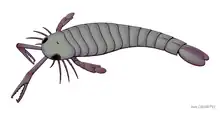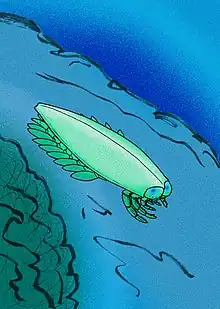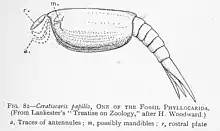Patrick Burn Formation
The Patrick Burn Formation is a Silurian aged geologic formation outcropping near Lesmahagow in Lanarkshire in the Scottish Lowlands. Fossils are known from the formation, including from the Birk Knowes locality.[1][2]
| Patrick Burn Formation | |
|---|---|
| Stratigraphic range: Upper | |
| Type | Formation |
| Unit of | Priesthill Group |
| Underlies | Castle Formation |
| Overlies | Ponesk Burn Formation (presumed, actual boundary is cut by a fault) |
| Thickness | 850 m |
| Lithology | |
| Primary | Sandstone, Siltstone, Mudstone |
| Location | |
| Region | Scotland |
| Country | |
Description
According to the British Geological Survey, the primary lithology of the formation consists of "Alternating beds of grey feldspathic, medium-grained turbiditic sandstone and grey siltstone with beds of grey laminated siltstone and silty mudstone."[3] The Birk Knowes site contains fossils from non-marine or marginal marine environment.[4] In 2000, Birk Knowes was closed by the Scottish government agency Scottish Natural Heritage (now NatureScot), due to the theft of specimens from the site by amateur collectors during the preceding decades, who essentially exhausted the fossiliferous deposit. At least some of the fossils ended up in a museum in Berlin, who refused to return them.[5][6][7][8]
Paleobiota
Arthropods
| Arthropods | |||
|---|---|---|---|
| Species | Notes | Images | |
| Slimonia acuminata | A slimonid eurypterid. |  | |
| Erettopterus bilobus | A pterygotid eurypterid. |  | |
| ?Nanahughmilleria lanceolata | An adelophthalmid eurypterid. | ||
| ?Hardieopterus lanarkensis | A hardieopterid eurypterid. | ||
| Loganamaraspis dunlopi | A chasmataspidid. | ||
| Cyamocephalus loganensis | A synziphosurine. |  | |
| Pseudoniscus falcatus | A synziphosurine. | ||
| Ainiktozoon loganense | A thylacocephalan. |  | |
| Ceratiocaris papilio | A phyllocarid. |  | |
Chordates
| Chordates | |||
|---|---|---|---|
| Species | Notes | Images | |
| Loganellia scotica | A loganelliid thelodont. |  | |
| Jamoytius kerwoodi | An enigmatic chordate. |  | |
References
- Various Contributors to the Paleobiology Database. "Fossilworks: Gateway to the Paleobiology Database". Retrieved 17 December 2021.
- D., Dineley; S., Metcalf (1999). Fossil Fishes of Great Britain. Geological Conservation Review Series. Vol. No. 16. Peterborough. ISBN 1-86107-470-0.
- Žigaitė, Živile; Goujet, Daniel (2012). "New observations on the squamation patterns of articulated specimens ofLoganellia scotica(Traquair, 1898) (Vertebrata: Thelodonti) from the Lower Silurian of Scotland". Geodiversitas. 34 (2): 253–270. doi:10.5252/g2012n2a1. ISSN 1280-9659. S2CID 73663549.
- "Patrick Burn Formation". BGS Lexicon of Named Rock Units. British Geological Survey. Retrieved 2 September 2023.
- Tetlie, O. Erik; Braddy, Simon J. (2003). "The first Silurian chasmataspid, Loganamaraspis dunlopi gen. et sp. nov. (Chelicerata: Chasmataspidida) from Lesmahagow, Scotland, and its implications for eurypterid phylogeny". Earth and Environmental Science Transactions of the Royal Society of Edinburgh. 94 (3): 227–234. doi:10.1017/S0263593300000638. ISSN 1473-7116. S2CID 73596575.
- Williams, Huw (2003). "Filched Fish Fossils". BBC Radio 4 Today. Retrieved 12 January 2023.
- Hose, Thomas A. (1 April 2012). "3G's for Modern Geotourism". Geoheritage. 4 (1): 7–24. doi:10.1007/s12371-011-0052-y. ISSN 1867-2485. S2CID 144250723.
- Langlands, Eva (1 September 2023). "Looters destroy Scotland's fossil heritage sites". ISSN 0140-0460. Retrieved 1 September 2023.
- University of Glasgow 23 May 2002 MOVE TO HALT FOSSIL THEFT AND DAMAGE IN SCOTLAND